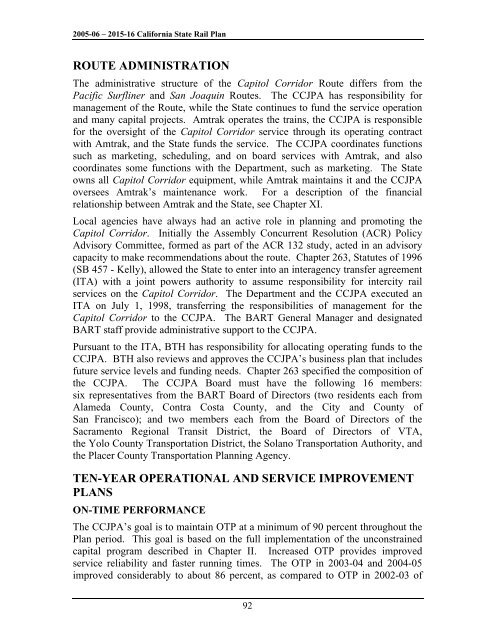California State Rail Plan 2005-06 to 2015-16
California State Rail Plan 2005-06 to 2015-16
California State Rail Plan 2005-06 to 2015-16
Create successful ePaper yourself
Turn your PDF publications into a flip-book with our unique Google optimized e-Paper software.
<strong>2005</strong>-<strong>06</strong> – <strong>2015</strong>-<strong>16</strong> <strong>California</strong> <strong>State</strong> <strong>Rail</strong> <strong>Plan</strong><br />
ROUTE ADMINISTRATION<br />
The administrative structure of the Capi<strong>to</strong>l Corridor Route differs from the<br />
Pacific Surfliner and San Joaquin Routes. The CCJPA has responsibility for<br />
management of the Route, while the <strong>State</strong> continues <strong>to</strong> fund the service operation<br />
and many capital projects. Amtrak operates the trains, the CCJPA is responsible<br />
for the oversight of the Capi<strong>to</strong>l Corridor service through its operating contract<br />
with Amtrak, and the <strong>State</strong> funds the service. The CCJPA coordinates functions<br />
such as marketing, scheduling, and on board services with Amtrak, and also<br />
coordinates some functions with the Department, such as marketing. The <strong>State</strong><br />
owns all Capi<strong>to</strong>l Corridor equipment, while Amtrak maintains it and the CCJPA<br />
oversees Amtrak’s maintenance work. For a description of the financial<br />
relationship between Amtrak and the <strong>State</strong>, see Chapter XI.<br />
Local agencies have always had an active role in planning and promoting the<br />
Capi<strong>to</strong>l Corridor. Initially the Assembly Concurrent Resolution (ACR) Policy<br />
Advisory Committee, formed as part of the ACR 132 study, acted in an advisory<br />
capacity <strong>to</strong> make recommendations about the route. Chapter 263, Statutes of 1996<br />
(SB 457 - Kelly), allowed the <strong>State</strong> <strong>to</strong> enter in<strong>to</strong> an interagency transfer agreement<br />
(ITA) with a joint powers authority <strong>to</strong> assume responsibility for intercity rail<br />
services on the Capi<strong>to</strong>l Corridor. The Department and the CCJPA executed an<br />
ITA on July 1, 1998, transferring the responsibilities of management for the<br />
Capi<strong>to</strong>l Corridor <strong>to</strong> the CCJPA. The BART General Manager and designated<br />
BART staff provide administrative support <strong>to</strong> the CCJPA.<br />
Pursuant <strong>to</strong> the ITA, BTH has responsibility for allocating operating funds <strong>to</strong> the<br />
CCJPA. BTH also reviews and approves the CCJPA’s business plan that includes<br />
future service levels and funding needs. Chapter 263 specified the composition of<br />
the CCJPA. The CCJPA Board must have the following <strong>16</strong> members:<br />
six representatives from the BART Board of Direc<strong>to</strong>rs (two residents each from<br />
Alameda County, Contra Costa County, and the City and County of<br />
San Francisco); and two members each from the Board of Direc<strong>to</strong>rs of the<br />
Sacramen<strong>to</strong> Regional Transit District, the Board of Direc<strong>to</strong>rs of VTA,<br />
the Yolo County Transportation District, the Solano Transportation Authority, and<br />
the Placer County Transportation <strong>Plan</strong>ning Agency.<br />
TEN-YEAR OPERATIONAL AND SERVICE IMPROVEMENT<br />
PLANS<br />
ON-TIME PERFORMANCE<br />
The CCJPA’s goal is <strong>to</strong> maintain OTP at a minimum of 90 percent throughout the<br />
<strong>Plan</strong> period. This goal is based on the full implementation of the unconstrained<br />
capital program described in Chapter II. Increased OTP provides improved<br />
service reliability and faster running times. The OTP in 2003-04 and 2004-05<br />
improved considerably <strong>to</strong> about 86 percent, as compared <strong>to</strong> OTP in 2002-03 of<br />
92













